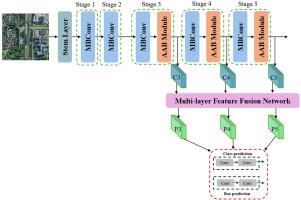AAB-FusionNet: A real-time object detection model for UAV edge computing platforms
IF 1.9
Q2 MULTIDISCIPLINARY SCIENCES
引用次数: 0
Abstract
Unmanned aerial vehicles (UAVs) often operate under stringent resource constraints while requiring real-time object detection, which can lead to failures in cluttered backgrounds or when targets are small or partially occluded. To address these challenges, we introduce AAB-FusionNet, a real-time detection model specifically designed for UAV edge computing platforms. At its core is the Adaptive Attention Block (AAB), which employs an Adaptive Saliency-based Attention (ASA) mechanism to highlight the most discriminative tokens while a lightweight MBConv sub-layer refines local spatial features. This saliency-driven framework ensures the network remains focused on critical cues despite complex aerial imagery. To further boost performance, AAB-FusionNet utilizes a Multi-layer Feature Fusion Network that integrates three key components: Attentive Inverted Bottleneck Aggregation (AIBA) to restore significant details at multiple scales, DySample for preserving spatial fidelity during feature alignment, and the Dual-Attention Noise Mitigation (DNM) module to suppress environmental noise through complementary channel and spatial attention. Experiments on diverse aerial datasets confirm that AAB-FusionNet achieves robust detection, especially for small or partially occluded objects, while offering real-time inference on low-power hardware. Overall, AAB-FusionNet effectively balances accuracy, computational efficiency, and adaptability, making it ideally suited for UAV scenarios demanding fast, reliable object detection and robust and consistent performance.
- •Incorporates an Adaptive Saliency-based Attention mechanism to emphasize critical visual cues.
- •Introduces a Multi-layer Feature Fusion Network for detail restoration, feature alignment, and noise mitigation.
- •Demonstrates real-time, high-accuracy detection on low-power UAV platforms, particularly for small or occluded targets.

AAB-FusionNet:无人机边缘计算平台实时目标检测模型
无人机通常在严格的资源限制下运行,同时需要实时目标检测,这可能导致在杂乱背景下或目标很小或部分遮挡时失败。为了应对这些挑战,我们引入了AAB-FusionNet,这是一种专门为无人机边缘计算平台设计的实时检测模型。其核心是自适应注意块(AAB),它采用基于自适应显著性的注意(ASA)机制来突出最具区别性的令牌,而轻量级的MBConv子层则细化局部空间特征。这种显著性驱动的框架确保了网络在复杂的航空图像下仍然专注于关键线索。为了进一步提高性能,AAB-FusionNet采用多层特征融合网络,该网络集成了三个关键组件:专注的反向瓶颈聚合(AIBA),用于在多个尺度上恢复重要细节,dyssample用于在特征对准过程中保持空间保真度,双注意噪声缓解(DNM)模块通过互补通道和空间注意来抑制环境噪声。在不同航空数据集上的实验证实,AAB-FusionNet实现了鲁棒的检测,特别是对于小或部分遮挡的物体,同时在低功耗硬件上提供实时推断。总体而言,AAB-FusionNet有效地平衡了准确性、计算效率和适应性,使其非常适合要求快速、可靠的目标检测以及鲁棒性和一致性性能的无人机场景。•结合适应性显著性为基础的注意机制,强调关键的视觉线索。•引入多层特征融合网络,用于细节恢复、特征对齐和降噪。•演示了在低功率无人机平台上的实时、高精度检测,特别是对小型或遮挡目标。
本文章由计算机程序翻译,如有差异,请以英文原文为准。
求助全文
约1分钟内获得全文
求助全文
来源期刊

MethodsX
Health Professions-Medical Laboratory Technology
CiteScore
3.60
自引率
5.30%
发文量
314
审稿时长
7 weeks
期刊介绍:
 求助内容:
求助内容: 应助结果提醒方式:
应助结果提醒方式:


